It’s not every day that an open-source, portable Linux handheld computer gets announced, so I couldn’t resist placing an order for the DevTerm by ClockworkPi back when we first learned about the stylish little terminal, which includes a 1280 x 480 screen (double-wide VGA) and a modular little thermal printer.
Of course, the global semiconductor shortage combined with shipping slowdowns led to delays, but things did ultimately come together for the project. I’ve always been a sucker for small-format machines, especially ones that come as a well-designed kit, and that means I can tell you all about what it was like to put it together and turn it on. There’s a lot to look at, so let’s get started.
A Well-Designed Kit
Assembly of the DevTerm makes for a good weekend or afternoon project. Clever design of interlocking pieces and connectors means there is no soldering required, and assembly mainly consists of clicking together hardware modules and plastic pieces according to the manual. Anyone with experience assembling plastic model kits will get a hit of nostalgia from cutting plastic parts off their sprues, and snapping them together.
Illustrations in the manual are good, and genuinely clever mechanical design makes for a very friendly assembly process. The use of self-centering parts, and pegs that themselves become self-aligning bosses, is pretty slick. No tools are required, and with the exception of two small screws for securing the processor module, there are in fact no hardware fasteners at all.
Of course, some parts are delicate and not entirely foolproof, but anyone with experience in electronics assembly should have no problem whatsoever putting it together.
The only elements that aren’t included are two 18650 cells for power, and 58 mm wide thermal paper rolls for the printer. A small phillips head screwdriver will be needed for the two small screws that secure the computing module into its socket.
Modular Components
Besides the screen and printer, inside the DevTerm there are four major assemblies; each connects to others with no need to solder anything. The keyboard with mini trackball is completely self-contained and connects via pogo pins. The main board holds the CPU. The EXT board has a fan and also provides I/O ports: USB, USB-C, Micro HDMI, and audio. The remaining board handles power management and hosts two 18650 cells — the USB-C port, by the way, is used exclusively for charging. There’s even some space left inside for customization or other add-ons.
This modularity pays off. For example, it helps make it possible for the DevTerm to offer a few different options for processors and memory sizes, including one based around the Raspberry Pi CM3+ Lite, which is the guts of a Raspberry Pi 3 Model B+ in a form factor intended for integration into other hardware.
The GitHub repository for the DevTerm has schematics, code, and reference info like board outlines; there are no design files in the sense of CAD formats, but those might be coming in the future. The product page mentions that CAD files for customizing or 3D printing one’s own parts are available from the GitHub repository, but at this writing they aren’t there yet.
Using the DevTerm
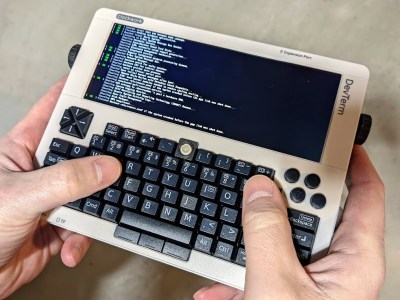
When powered up, the DevTerm boots directly into a desktop environment, and one of the first things I wanted to do was configure a WiFi connection and enable an SSH server. The welcome screen told me exactly how to do that — but the early version of the OS my DevTerm shipped with had a small typo which meant that following the directions exactly resulted in an error, which helped deliver a genuine Linux DIY experience. A few other things also didn’t seem quite right, but a software update did a lot to fix that up.
The default behavior of the mini trackball was especially frustrating, as it moved the pointer only a tiny bit with each swipe of a finger. In addition, the trackball doesn’t seem to respond well to diagonal movement. Thankfully, user [guu] has rewritten the firmware for the keyboard and I highly recommend the updated version, which improves the trackball response considerably. The keyboard module can be programmed with new firmware from a shell on the DevTerm itself, but it is a much better idea to do it from an ssh session, because the physical keyboard can become unresponsive in the process.
Updating my DevTerm A04 to the latest OS release fixed most of the issues I noticed out of the box — such as no sound coming from the speakers, leading me to wonder if I had installed them correctly — so I recommend ensuring that the OS is updated before diving too far into troubleshooting any particular issue.
Keyboard and Mini Trackball
The keyboard module includes a mini trackball and three separate mouse buttons, and clicking the trackball performs a left-click by default. The layout has a nice look to it, with the trackball centered at the top of the keyboard, and three mouse buttons centered under the space bar.
ClockworkPi’s “65% keyboard” has a classic key layout, and I found the DevTerm to be easiest to type on when I held it with both hands and typed with my thumbs, as though it were an oversized Blackberry. Laying the DevTerm down on a tabletop is also an option; this puts the keyboard at an angle that invites more traditional finger typing, but I found the keys a bit small to do this comfortably.
There is no touchscreen, so navigating a GUI means using the trackball, or using keyboard shortcuts. Fiddling a mini trackball located in the center of the device — with mouse buttons at the bottom edge — is something I found a bit awkward at best. Functionally, the DevTerm’s keyboard and trackball combo provides all the right tools one may need in a space efficient and balanced layout; it’s just not the most ergonomic in terms of usability.
Remote Access is More Comfortable Access
One isn’t always using the DevTerm as a portable machine. When configuring or otherwise doing setup, logging in with an ssh session is a better way to go than dealing with the built-in keyboard.
Another alternative is setting up remote desktop access, so that the DevTerm can be used in all its widescreen 1280 x 480 double-VGA glory, from the comfort of one’s desktop.
To do that as quickly as possible, I installed the vino package on the DevTerm, and used TightVNC viewer from my desktop to establish a remote session.
Vino is a VNC server for the GNOME desktop environment, and TightVNC viewer is available for a wide variety of systems. sudo apt install vino will get the VNC server installed (listening on default TCP port 5900), and while I don’t actually recommend this for everyone, following it up with gsettings set org.gnome.Vino require-encryption false will enforce precisely zero authentication or security whatsoever on the connection, allowing one to access the DevTerm desktop with nothing more than the machine’s IP address.
Not the best security-minded decision, but it did allow me to avoid the trackball and keyboard in no time flat, which has a value all its own in a pinch.
Tiny Thermal Printing
The thermal printer is an unexpected feature, and the paper spool is held in a separate, removeable assembly. In fact, the printer functionality is entirely modular. The printing hardware inside the DevTerm is situated directly behind an expansion port feature into which the paper reservoir is inserted when printing. This assembly could be removed entirely and the space repurposed, if so desired.
Functionally, the small printer works perfectly well and I was able to do test prints with no trouble — as long as my batteries had a healthy charge. Printing with low battery power resulted in an ungraceful brownout, so avoid that situation. That’s probably worth keeping in mind with regards to any modifications, too.
Print quality and resolution is much like any receipt printer, so moderate your expectations if you have any. Is the little printer a gimmick? Maybe, but it’s sure a nifty option and can be used as a sort of reference design, should one wish to refit the DevTerm with some other custom hardware in its place.
A Hackable, Handheld Linux Experience
Clockworkpi have clearly put effort into giving the DevTerm a hackable nature; the connectors between modules are easy to access, and there is spare room on the boards as well as some extra room inside the case. In particular, the thermal printer module has a generous amount of extra room behind it. There’s definitely space for some wiring and custom hardware, should one wish to break out a soldering iron. The modular nature of the main assemblies also seems designed to invite easy modification, which helps make it an attractive starting point for a cyberdeck build.
While 3D models of the physical bits are not currently available on the project’s GitHub, an enterprising soul has nevertheless created a 3D printable DevTerm stand that cradles the device and puts it at a useful and space-saving angle. When 3D models of parts make it to the GitHub repository, that’ll make things a lot easier.
What do you think about the design choices this Linux handheld took? Got any ideas for hot hardware mods? As mentioned, the print module (and the expansion slot that goes with it) could be easily repurposed; I’m a bit partial to Tom Nardi’s idea of USB devices in cartridge format, personally. Got any other ideas? Let us know in the comments!






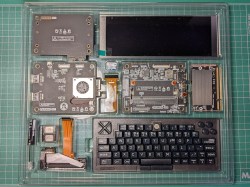
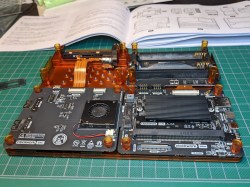

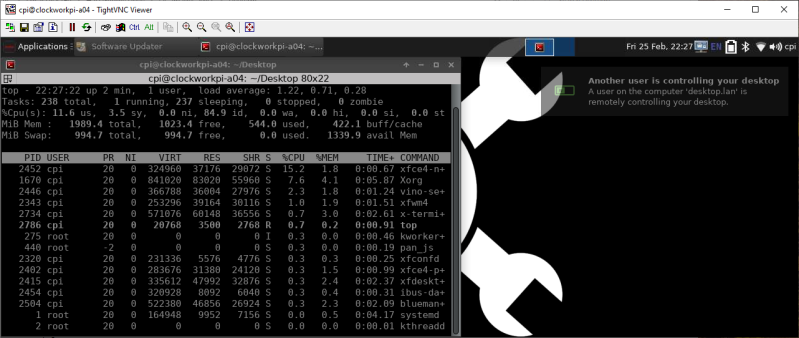
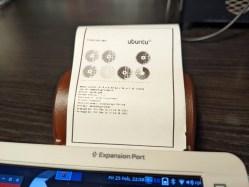

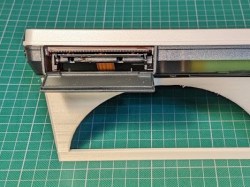













That device is crying for a mod where the round side things would be encoders scrolling text instead of just holding things together.
Totally. I thought that’s what they were!
So did I when I pré-ordered the device. But unfortunately not : they’re just screwless hold-in-place recognizable Cogs so you can save 5seconds When you want to open your device and hack inside-
I thought it was a Raspberry Pi in a Model 100, then Irealized more like the NEC PC-8201.
But the holding it dwarfs it, so it’s just a copy.
If only the Model 100 screen was denser, use it as a terminal to a linux computer. One company had a larger bottom to replace the existing one, use that to add a current computer
DevTerm replaced my hacked up Tandy WP-2 (Citizen CBM-10WP). Keyboard on the WP-2 is better than the DevTerm’s due to size. But the stock ROM of the WP-2 is horrible and demands hacking just for usability sake (CamelForth is pretty straight forward to load in, thanks to the service manuals including helpful examples).
With DevTerm, I’m running a pretty complete Linux with a early-2000’s level of performance. I’m pretty happy with Window Maker and some tweaked xterm configuration for full screen and 3270 fonts. But i3, dwm, ratpoison, etc are also pretty good choices on the DevTerm’s screen and trackball.
Ah yes, the NeckPain 2000TM
I’m tired of typing on touch screens. More mobile plus keyboard projects pls.
I use mine almost exclusively for ham radio stuff, particularly love using it for aprs, I would love to see a drop in carrier board to glom a baofeng motherboard into it and controlled via a serial interface, or possibly a cheap internal gps receiver, huge potential :)
I’m very interesting in the DevTerm for Ham digital use. Have you used it with JS8Call ?
ugly keyboard ;(
one question how long this device work on one charge?
I don’t think I’ve ever seen a winking cry emote before
Such a professional design, and yet the display is in plane with the keyboard. How many times do we have to teach you this lesson, old man?
https://youtu.be/ymHyOmlUlP0
So, how should it be, then?
Check out the Psion based Gemini PDA
https://youtu.be/Oi6N4m59f88
Even the TRS-80 Model 100 eventually learned to have a tilt-able screen with the Model 200. But the flat looks so good!
If it turns out not to be vaporware, the Popcorn Pocket PC would be even more interesting (GNSS, LoRa, FHD screen, etc), but so far they have provided only 3D renders. https://pocket.popcorncomputer.com/
Or a pinephone with the keyboard case.
“When will mine ship?
Our goal is to ship production units by June 2021. Based on our experience producing products in high volume, we believe our goal is attainable as long as there aren’t any unforeseen setbacks. We promise to be as transparent as possible and will regularly post updates in our community forum.”
I’ve been thirsting over this thing for months, but this is the first time I’ve seen a picture of it in somebody’s hands (thx!) & I’m SHOCKED by how small it is. Makes this useless for the distraction free writing or travel-hacking use cases I had imagined :/
Indeed, it seems simultaneously too big and too small for any use I can think of – its not quite small enough for that pocket sized ssh machine with the real physical keyboard for that haptic feedback you actually did only press the key you wanted – handy to carry with you for all your config and control needs, and it does not look big enough to really use, at least for those of us with bigger hands.
Very interesting though, and I’m sure there will be some great uses for it out there, but none come to mind for me.
I picked one up and I’m still trying to come up with a killer app for it. I have normal size hands (not dainty but not monsters) and the keyboard is surprisingly useable. It’s roughly the size of a thick iPad so it’s easy enough to carry around but you’re not going to slip it into a pocket. My biggest complaint is that the screen ratio is hard to fully exploit unless you park two windows side by side.
I’m going to keep playing with it and see what it wants to be used for.
It does have very good battery life so at least you’re pretty confident it’s going to have a charge.
For me once it gets to a size that to carry it around requires a bag it doesn’t make any odds if its Ipad sized, or thicker chunky laptop size, as long as it isn’t too big or heavy to fit in the normal bag – its no trouble carting my much loved Toughbook CF-19’s around for instance, and those things are probably 2″ thick (deceptively light though)…
Which leads me to think if you are going bigger than pocket size you might as well go big enough to be really comfortable use (which the CF-19’s don’t really get my seal of approval on – but durable and silent are the priorities with them) – doesn’t need to be ergonomically ideal (as no portable can be that), just have good typing/mouse experience (but then again if its nice for smaller handed folk its not nice for bigger handed and visvesa so how big that is isn’t concrete measurements).
Still this thing is interesting enough I’m tempted (and if I could just afford it effortlessly I would get one).
I can see this being more comfortable for travel, it is quite light. My laptop is an old MacBook Pro and it does get a little heavy as the day goes on. The DevTerm is closer to the iPad than a laptop in that regard.
If all you need is an SSH terminal, though, I’m not sure it’s superior to an iPad with a terminal application like Termius. If you need an actual *nix device, though, it’s got you.
The way to type on the DevTerm is with two thumbs, like a Blackberry. Goes quite well there. That’s also why the flat screen is not a problem and doesn’t need to tilt up, you’re holding it in your hands instead of having it on your lap.
Interesting take – but to me even with my giant hands that looks a bit too large and not very ergonomic to thumb type – the middle of the keyboard seems too far away with rather hard corners digging into your palms – not having hands on I might be wrong there of course.
But still I think it would shine far better if it was a smaller device with a physical keyboard to thumb type on – in that pocket sized range like those early smartphones that had slide out keyboards to end up with a similar form factor to this in use. As really its that pocketablity but with the physical keyboard I would most want out of a device like this – the take anywhere sshing platform for those times you really need to change something on a headless machine. Onscreen keyboards are really awful for everything… Or perhaps that next size up so you can type on normally.
I’d agree though that some laptops can get heavy, but they don’t have to be – pay up for whatever features are most important to you on that front. Personally weight never really bothered me – quite happily lugged a ‘desktop replacement’ class laptop from the Pentium 4 era around with heaps of textbook in the rucksack that was probably well over 20Kg all told – the performance computer and convenience of having everything else needed for that day with me all day outdid the minor inconvenience of it being heavy…
The 3D models have been available since this past summer at least. They are on the store page (for free) instead of github for some reason.
Loved my libretto and 200lx, so keep trying. Trackball maybe could move to the right. How about two, on each side, software controls which is fast and which is slow. 1280 might be interesting if it rotates from landscape to portrait.
a fast trip down 2k memory lane for us old Tandy fans.
thanks
I have this device and love using it but it’s dead in the water. None of the kernel patches are being upstreamed, so like a million ARM devices before it, it’s tied to one vendor-supplied kernel with little hope of updates.
I want one and have the gameshell before it, but its just too expensive/
could you imagine doing your homework on this and printing it out for your teacher?
I wouldn’t mind creating a purpose built OS for this, the printer is very useful in my opinion.
A trs-80 was my note taking laptop for many years, simple and effective. The second that they come out with an Ortho keyboard for this I am buying one.